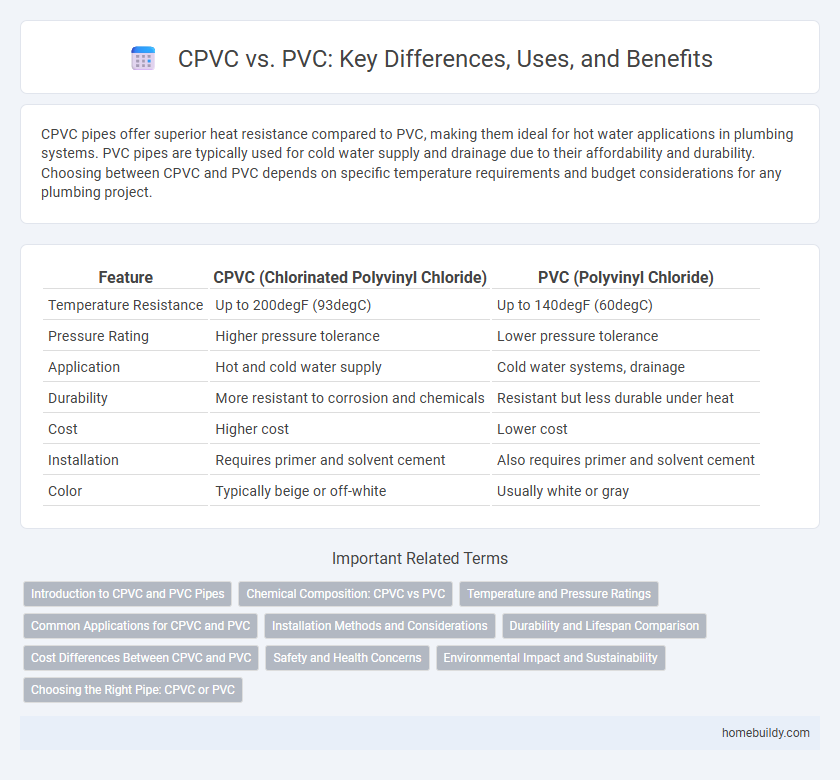CPVC pipes offer superior heat resistance compared to PVC, making them ideal for hot water applications in plumbing systems. PVC pipes are typically used for cold water supply and drainage due to their affordability and durability. Choosing between CPVC and PVC depends on specific temperature requirements and budget considerations for any plumbing project.
Table of Comparison
| Feature | CPVC (Chlorinated Polyvinyl Chloride) | PVC (Polyvinyl Chloride) |
|---|---|---|
| Temperature Resistance | Up to 200degF (93degC) | Up to 140degF (60degC) |
| Pressure Rating | Higher pressure tolerance | Lower pressure tolerance |
| Application | Hot and cold water supply | Cold water systems, drainage |
| Durability | More resistant to corrosion and chemicals | Resistant but less durable under heat |
| Cost | Higher cost | Lower cost |
| Installation | Requires primer and solvent cement | Also requires primer and solvent cement |
| Color | Typically beige or off-white | Usually white or gray |
Introduction to CPVC and PVC Pipes
CPVC (Chlorinated Polyvinyl Chloride) and PVC (Polyvinyl Chloride) pipes are widely used for plumbing applications, with CPVC offering enhanced temperature resistance up to 200degF, making it suitable for hot water systems, while PVC is typically rated for cold water use under 140degF. Manufactured from different chemical processes, CPVC undergoes chlorination, increasing its durability and chemical resistance compared to PVC. Both pipe types provide corrosion resistance and ease of installation, but selecting between CPVC and PVC depends on specific temperature requirements and application conditions in plumbing systems.
Chemical Composition: CPVC vs PVC
CPVC (Chlorinated Polyvinyl Chloride) differs from PVC (Polyvinyl Chloride) due to the presence of added chlorine atoms in its polymer chain, which increases its chemical resistance and temperature tolerance. The chlorination process in CPVC enhances its ability to withstand high temperatures up to 200degF (93degC), compared to PVC's limit of around 140degF (60degC). This chemical composition difference makes CPVC more suitable for hot water plumbing applications, while PVC is primarily used for cold water and drainage systems.
Temperature and Pressure Ratings
CPVC pipes offer higher temperature resistance, typically handling up to 200degF (93degC), compared to PVC pipes, which withstand temperatures up to 140degF (60degC). CPVC also maintains greater pressure ratings at elevated temperatures, making it suitable for hot water applications and industrial use. PVC pipes generally perform well under pressures up to 450 psi but are limited in hot water systems due to their lower heat tolerance.
Common Applications for CPVC and PVC
CPVC pipes are commonly used for hot and cold water distribution in residential and commercial plumbing due to their ability to withstand higher temperatures and corrosion resistance. PVC pipes are primarily utilized for cold water applications, irrigation systems, and drainage because of their durability and affordability. Both materials are essential in plumbing, with CPVC favored for potable water systems and PVC ideal for waste and vent piping.
Installation Methods and Considerations
CPVC pipes require solvent cementing and are suitable for hot and cold water applications due to their heat resistance, while PVC pipes use a similar solvent cementing process but are typically limited to cold water or drainage systems. CPVC installation demands careful handling to avoid excessive heat exposure that can compromise joint integrity, whereas PVC installation prioritizes avoiding UV exposure to prevent material degradation. Both materials must ensure proper pipe support and alignment during installation to maintain system performance and prevent leaks.
Durability and Lifespan Comparison
CPVC pipes offer superior durability compared to PVC due to their resistance to higher temperatures and chemical corrosion, making them ideal for hot water applications. PVC pipes, while cost-effective and lightweight, have a shorter lifespan in environments exposed to intense heat and UV radiation. On average, CPVC pipes can last up to 50 years under optimal conditions, whereas PVC pipes typically have a lifespan of 25 to 40 years depending on usage and exposure.
Cost Differences Between CPVC and PVC
CPVC pipes generally cost more than PVC pipes due to their higher temperature resistance and enhanced durability in hot water applications. The price difference can be attributed to CPVC's chemical composition, which allows it to withstand temperatures up to 200degF, whereas PVC typically handles temperatures up to 140degF. For budget-conscious plumbing projects where hot water resistance is not critical, PVC offers a more cost-effective solution.
Safety and Health Concerns
CPVC pipes resist higher temperatures and avoid leaching harmful chemicals into drinking water, making them safer for hot water plumbing compared to PVC pipes. PVC pipes can release toxic chemicals like vinyl chloride when exposed to high heat or fire, posing health risks. Choosing CPVC reduces potential exposure to carcinogenic substances and ensures compliance with safety regulations in residential and commercial plumbing systems.
Environmental Impact and Sustainability
CPVC pipes have a higher environmental impact than PVC due to their chlorine content and more energy-intensive manufacturing process. PVC pipes are more widely recycled and have a longer lifespan, contributing to their sustainability in plumbing applications. Both materials pose challenges for disposal and incineration, releasing harmful chemicals, but PVC's established recycling infrastructure makes it a relatively greener option.
Choosing the Right Pipe: CPVC or PVC
CPVC pipes offer superior heat resistance and corrosion protection compared to PVC, making them ideal for hot water applications and industrial settings. PVC pipes are more cost-effective and widely used for cold water supply, irrigation, and drainage systems due to their rigidity and chemical resistance. Selecting between CPVC and PVC depends on temperature requirements, pressure ratings, and budget considerations to ensure optimal performance and durability.
CPVC vs PVC Infographic

 homebuildy.com
homebuildy.com